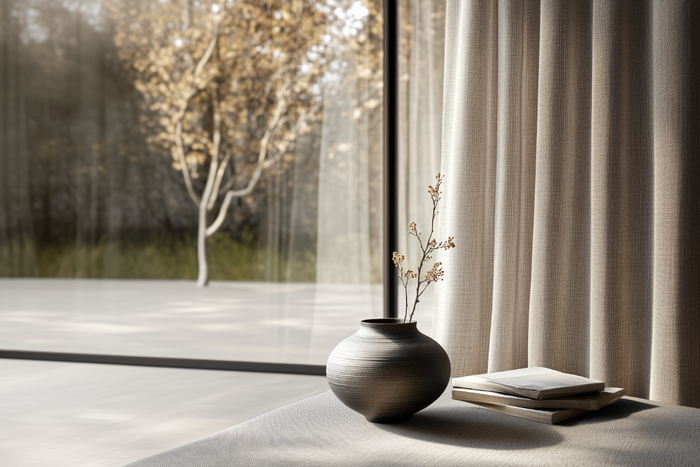
Contract Curtains for Hospitality & Commercial Interiors
Contract Curtains for Hospitality & Commercial Interiors
Introduction
Contract curtains are essential in hospitality and commercial interiors because they influence aesthetics and performance standards while ensuring safety and regulatory compliance. Interior designers who work on hotel, restaurant, office, healthcare or retail space projects need to understand the functional and technical specifications of contract-grade window treatments to effectively specify them. The article explores essential elements such as materials, standards, specifications and sourcing to help you make confident design decisions.
What Are Contract Curtains?
Contract curtains represent commercial window treatments designed with durability, safety features, and functionality that handle the demands of high-traffic settings. Commercial-grade contract curtains require strict adherence to fire safety protocols and performance standards for light blocking and acoustic properties along with maintenance requirements. These are not off-the-shelf solutions. Contract curtains undergo specification and manufacturing processes to fulfill precise project requirements and adhere to regulatory standards while maximizing operational efficiency and brand identity.
Key Applications in Commercial Design
Hospitality Sector
Guest rooms in hotels require blackout curtains to ensure sleep quality and guest comfort. Dual-track systems merge sheer fabrics with blackout layers in their design.
Acoustic curtains function both as room dividers and sound dampening devices in conference facilities. - Antimicrobial and stain-resistant fabrics protect restaurant hygiene while maintaining design integrity.
Healthcare Environments
Healthcare facilities' cubicle curtains require adherence to infection control standards and frequently need to include mesh headers so they meet sprinkler system requirements.
Patient safety in mental health care settings relies on installing anti-ligature curtains and breakaway tracks.
Corporate and Commercial Offices
AV systems in boardrooms use integrated motorised curtains for presentation enhancement.
Acoustic curtains enable open-plan workspaces to have defined zones while managing noise levels in the absence of permanent walls.
Compliance and Certification
Fire Retardancy Standards
All commercial interior fabrics in the UK must comply with BS 5867 Part 2 Type B/C standards.
All international projects should follow individual regional standards in the EU (EN 13773) and USA (NFPA 701). Design teams need to choose fabrics that are either naturally flame-retardant (IFR) or treated for fire resistance which come with proper certification. Repeated laundering does not diminish the fire safety of IFR fabrics.
Sustainability Certifications
Oeko-Tex Standard 100
Cradle to Cradle
Greenguard Gold
Certified fabrics help achieve LEED and WELL building standard certifications and fulfill client ESG targets.
Functional Performance Considerations
Light Control
Blackout drapes provide optimal light blocking for hospitality suites and presentation rooms.
Dimout window treatments create an environment with minimized glare while avoiding complete darkness.
Sheer curtains help distribute natural lighting while keeping spaces private. The implementation of multi-layered systems with double and triple tracks offers adaptable solutions for different time-of-day requirements.
Acoustics
Dense weave contract curtains or those with acoustic linings greatly reduce reverberation time in spaces such as restaurant lobbies and meeting rooms. Verify tested performance standards that meet ISO 354 for sound absorption.
Thermal Performance
Energy efficiency in glazed spaces with large windows gets enhanced by using thermally lined curtains in hospitality or office environments. Reflective linings enable temperature control inside buildings which helps to cut down HVAC energy usage.
Fabric Selection & Specification
Commercial fabrics must withstand at least 30,000 Martindale rubs according to standard durability requirements. - The ability to clean fabrics at 60°C and the need for stain resistance stand as essential factors for maintenance. - The fabric's texture and colorfastness along with its drape quality need to match both the brand identity and lighting conditions.
Fabric Type | Best Use Case | Notes |
|---|---|---|
Polyester IFR | General purpose | Widely used, cost-effective |
Wool Blends | Acoustic and premium hospitality | Natural look, high-end finish |
Trevira CS® | Healthcare, hospitality | Flame-retardant, versatile |
PVC Mesh | Cubicle curtains in healthcare | Allows sprinkler access, washable |
Hardware & Tracks
Manual vs. Motorised Systems
Manual: Cost-effective, reliable, suitable for low-tech environments.
Motorised systems serve luxury suites and auditoriums as well as modern office spaces. User control increases as lighting and HVAC systems integrate.
Track Systems
Ceiling-mounted: Offers a seamless, minimalist look.
Recessed tracks provide hidden installation for superior finishing details in high-end interior spaces.
Curved/Bendable tracks serve as versatile solutions for bay windows, privacy screens, and space zoning applications.
Specification work requires verification of weight limits and fabric compatibility.
Customisation & Branding
Utilizing custom dyeing techniques alongside digital printing and embroidery helps to match curtains with corporate and thematic design elements. Many hotels integrate subtle logos or motifs into sheer curtain layers for branding purposes while retail and hospitality spaces use curtains as narrative display surfaces. Ultraviolet light resistance is essential for areas receiving intense natural light when using bold or patterned drapery.
Procurement & Lead Times
Begin collaboration with contract fabric suppliers during the initial design phase. The lead time for contract fabric delivery usually falls within a 4 to 10-week range based on several factors.
Customisation requirements
Fabric origin and availability
Installation complexity
Choose vendors that deliver complete specification data sheets and installation assistance. ---
Cost Drivers
Contract curtain prices per linear metre range between £30 and over £150 based on various factors.
Fabric type and weave
Performance treatments (FR, acoustic, antimicrobial)
Track and motorisation requirements
Installation complexity
When budgeting for contract curtains evaluate their total cost of ownership rather than just their initial material cost. ROI can be substantially impacted by failures in maintenance practices and compliance requirements as well as reduced product lifespan. M
Mistakes to Avoid
Commercial-grade fabrics are necessary because residential fabrics fail to endure the demands of commercial wear and cleaning despite FR treatment.
The absence of fire labels along with incorrect mesh headers risks project delays during approval or occupancy processes.
Certain high-end fabrics need dry-cleaning which will increase long-term operational expenses. - Curtains are frequently installed late in the process so confirm that ceiling structures plus lighting and AV systems will not interfere with curtain tracks.